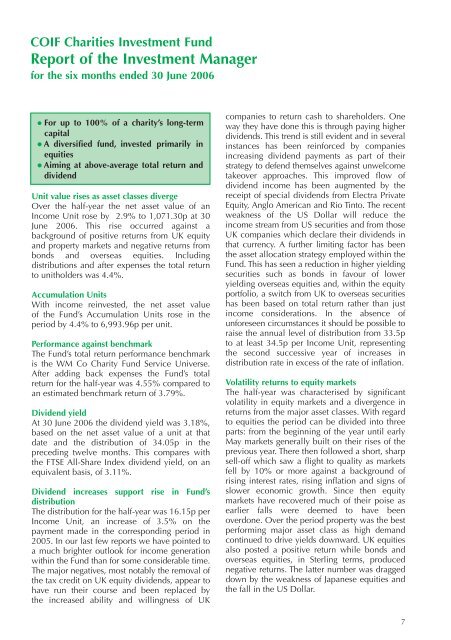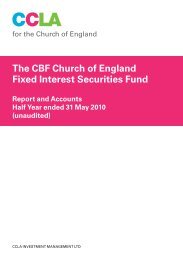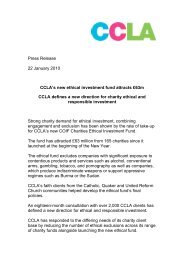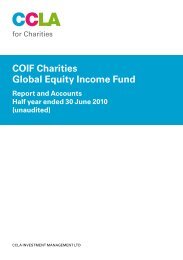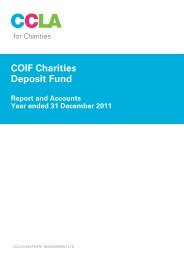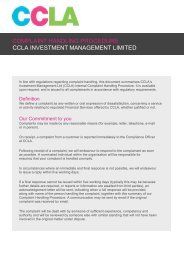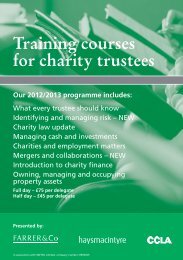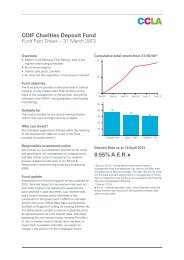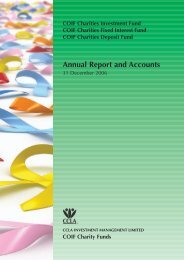COIF Charity Funds - CCLA
COIF Charity Funds - CCLA
COIF Charity Funds - CCLA
You also want an ePaper? Increase the reach of your titles
YUMPU automatically turns print PDFs into web optimized ePapers that Google loves.
<strong>COIF</strong> Charities Investment FundReport of the Investment Managerfor the six months ended 30 June 2006 For up to 100% of a charity’s long-termcapital A diversified fund, invested primarily inequities Aiming at above-average total return anddividendUnit value rises as asset classes divergeOver the half-year the net asset value of anIncome Unit rose by 2.9% to 1,071.30p at 30June 2006. This rise occurred against abackground of positive returns from UK equityand property markets and negative returns frombonds and overseas equities. Includingdistributions and after expenses the total returnto unitholders was 4.4%.Accumulation UnitsWith income reinvested, the net asset valueof the Fund’s Accumulation Units rose in theperiod by 4.4% to 6,993.96p per unit.Performance against benchmarkThe Fund’s total return performance benchmarkis the WM Co <strong>Charity</strong> Fund Service Universe.After adding back expenses the Fund’s totalreturn for the half-year was 4.55% compared toan estimated benchmark return of 3.79%.Dividend yieldAt 30 June 2006 the dividend yield was 3.18%,based on the net asset value of a unit at thatdate and the distribution of 34.05p in thepreceding twelve months. This compares withthe FTSE All-Share Index dividend yield, on anequivalent basis, of 3.11%.Dividend increases support rise in Fund’sdistributionThe distribution for the half-year was 16.15p perIncome Unit, an increase of 3.5% on thepayment made in the corresponding period in2005. In our last few reports we have pointed toa much brighter outlook for income generationwithin the Fund than for some considerable time.The major negatives, most notably the removal ofthe tax credit on UK equity dividends, appear tohave run their course and been replaced bythe increased ability and willingness of UKcompanies to return cash to shareholders. Oneway they have done this is through paying higherdividends. This trend is still evident and in severalinstances has been reinforced by companiesincreasing dividend payments as part of theirstrategy to defend themselves against unwelcometakeover approaches. This improved flow ofdividend income has been augmented by thereceipt of special dividends from Electra PrivateEquity, Anglo American and Rio Tinto. The recentweakness of the US Dollar will reduce theincome stream from US securities and from thoseUK companies which declare their dividends inthat currency. A further limiting factor has beenthe asset allocation strategy employed within theFund. This has seen a reduction in higher yieldingsecurities such as bonds in favour of loweryielding overseas equities and, within the equityportfolio, a switch from UK to overseas securitieshas been based on total return rather than justincome considerations. In the absence ofunforeseen circumstances it should be possible toraise the annual level of distribution from 33.5pto at least 34.5p per Income Unit, representingthe second successive year of increases indistribution rate in excess of the rate of inflation.Volatility returns to equity marketsThe half-year was characterised by significantvolatility in equity markets and a divergence inreturns from the major asset classes. With regardto equities the period can be divided into threeparts: from the beginning of the year until earlyMay markets generally built on their rises of theprevious year. There then followed a short, sharpsell-off which saw a flight to quality as marketsfell by 10% or more against a background ofrising interest rates, rising inflation and signs ofslower economic growth. Since then equitymarkets have recovered much of their poise asearlier falls were deemed to have beenoverdone. Over the period property was the bestperforming major asset class as high demandcontinued to drive yields downward. UK equitiesalso posted a positive return while bonds andoverseas equities, in Sterling terms, producednegative returns. The latter number was draggeddown by the weakness of Japanese equities andthe fall in the US Dollar.7


